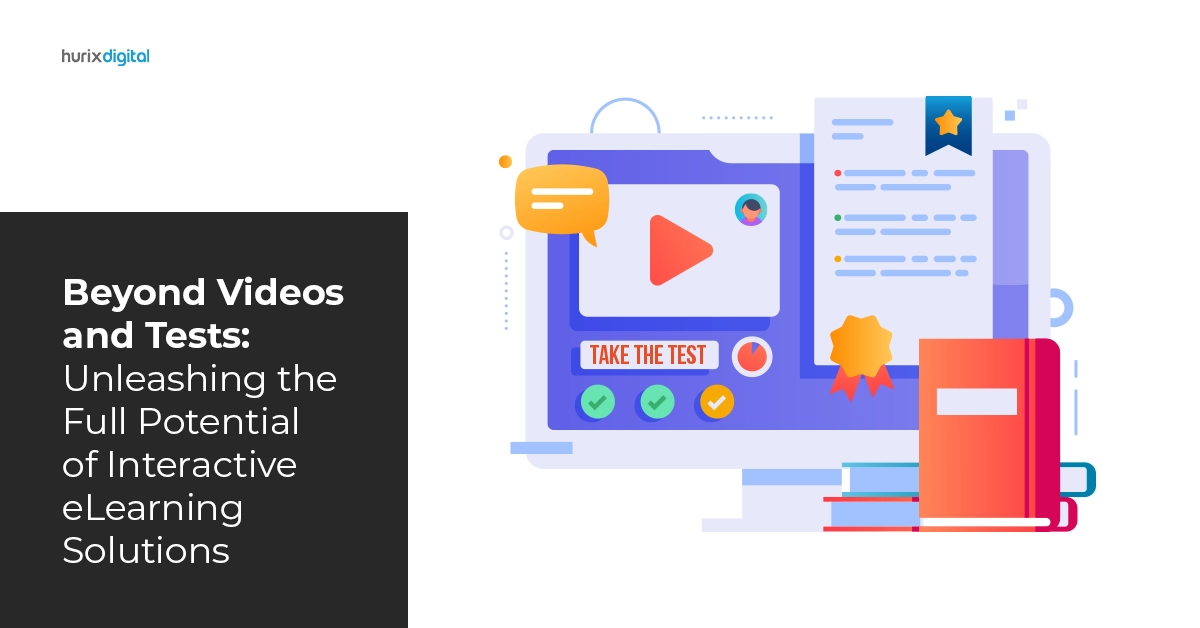
Beyond Videos and Tests: Unleashing the Full Potential of Interactive eLearning Solutions
Summary
Discover how to maximize the potential of interactive eLearning solutions. This article explores innovative approaches beyond traditional videos and tests.
The progression of education methodologies in the digital era has centred around the birth of electronic learning tools and solutions. These innovations changed the learning perspective from classical, one-dimensional to active, dynamic courses and included resources that suited a range of student needs and interests.
LMS (Learning Management Software) and LXP (Learning Experience Platform) integration of authoring tools has greatly improved the efficiency of eLearning in education because different platforms have specific advantages, and together they make eLearning more effective and engaging.
This conceptual investigation delineates how these technologies restructure education, allowing for personalized, immersive, and flexible knowledge intake.
Table of Contents:
- Evolution of eLearning Solutions in Education
- Understanding Interactivity in eLearning
- Providing Educators and Learners with Authoring Tools
- The Presence of Learning Management Software in Facilitating Education
- Enhancing Engagement with Learning Experience Platforms
- Custom eLearning Solutions to Match Learning to Individuals’ Particular Needs
- 5 Advantages of Interactive Online Learning
- 6 Best Practices in Interactive eLearning Solutions Implementation
- The Future of eLearning: Interactive Solutions at the Epicenter
- Conclusion
Evolution of eLearning Solutions in Education
The exploration of eLearning in education shows how technology development progresses alongside the evolution of pedagogy. From the first text-based online courses to the present time of virtual reality environments with immersion, eLearning solutions have experienced a noticeable change. The driving force for this evolution is more open, attractive, and comprehensive education models. With the advent of the 21st century, the central theme of eLearning as a means of active participation highlights changing the paradigm of information consumed to the one experienced.
Understanding Interactivity in eLearning
Interactive learning in eLearning is referred to as the level of active participation of the learners in the content instead of passively receiving it. undefined
- Simulations and Virtual Environments: Simulations, which involve practicing theoretical knowledge in real-life situations, enable the learners to develop problem-solving skills through experimenting in a risk-free setting. Virtual and real-world environments create a learning context that enhances memorability and application.
- Scenario-Based Learning: Ensuring the trainees are presented with real-life scenarios and making choices promotes critical thinking and problem-solving. Through moving through the situations and making their own decisions, enjoying the experience and consequences, learners come to know much more than they can learn theoretically.
- Gamification: Gamification techniques, for instance, badges, leaderboards, and rewards, turn rather dull learning activities into games, motivate the users, and increase their achievement. Gamification transforms learning into a more playful and competitive activity, which keeps learners engaged and enhances their ability to remember information for an extended period.
- Collaborative Learning: Interactive eLearning modes help foster learners’ collaboration through discussion forums, group projects, and peer reviews. Through the exchange of ideas, debates of concepts, and working together on assignments, learners participate in a varying and inclusive thinking process.
Providing Educators and Learners with Authoring Tools
Authoring tools in eLearning are essential for crafting learner-centric, interactive materials consistent with the learners’ specific needs and learning styles. One of the most significant advantages of the best eLearning authoring tools is their user-friendly interface and varied features that accommodate educators with different levels of technical proficiency to produce stimulating eLearning courses. Be it through quizzes or videos; these digital means are the sparkle of non-depressive but attractive eLearning programs.
The Presence of Learning Management Software in Facilitating Education
Learning management software has changed the traditional instructional approach to education by providing a complete platform for efficiently managing courses, tracking progress, and enhancing communication among educators and learners. LMS is more than a tool that deals with the logistical problems faced in education; it also optimizes the process by making it more efficient and effective.
Check out EXCLUSIVE: Hurix Minibook: Immersive Learning for the WIN in Education!
Enhancing Engagement with Learning Experience Platforms
eLearning experience platforms go beyond the learning experience by drawing on artificial intelligence and machine learning to develop individualized learning experiences. Unlike ordinary LMS, LXPs are user-centered and aim to deliver entertaining and interactive content according to the learner’s behavior, choices, and performance track. It guarantees continuous, adaptive, more relevant, and purposeful education.
Custom eLearning Solutions to Match Learning to Individuals’ Particular Needs
The modern age demands discarding the concept of one-size-fits-all when discussing effective education. Personalized education achieves its peak with custom eLearning solutions, providing students with tailored content and learning paths relevant to their speed, choice, and level of performance. Such customization accounts for the increase in the effectiveness and the pleasure of the learning experience, which guarantees higher success rates and outcomes.
5 Advantages of Interactive Online Learning
Adding interactive parts to eLearning solutions has big plusses for students and teachers:
- Boosted Participation: Fascinating and hands-on content draws learners’ focus, keeping them keenly absorbed in their studies. Disinterest can be tackled by making teaching fun and engaging, enhancing students’ memory.
- Better Retention of Lessons: Active involvement deepens learning and aids in memorizing details. Engaging in activities like games, simulations, and chats enables students to strengthen their grasp, making it easier to remember key points.
- Customized Study Experiences: Interactive eLearning platforms can be tailored to individual studying ways, offering personal advice and pointers. By customizing the study session for each student’s need, teachers can supercharge the interaction and effectiveness of learning.
- In Practice: Interactive tools like simulations and situation-based education allow students to use their textbook knowledge in real-life situations. It’s a bridge from what’s learned in theory to what happens in real life. Interactive online education readies students for real life and boosts their problem-solving ability.
- Insights From Data: Interactive eLearning platforms create valuable information about student involvement, advancement, and performance. With this info, teachers can spot what needs to get better. They can track student performance and choose wisely to optimize learning.
6 Best Practices in Interactive eLearning Solutions Implementation
While offering several benefits, implementing these interactive eLearning solutions requires accuracy in planning and consideration of best practices in designing and delivering interactive eLearning experiences in mind.
- Identify Learning Objectives: Start by identifying clear learning objectives and then plan how the interactive activities will support attaining these objectives. Confirm that each element has some specific educational role and contributes towards achieving the learning objectives.
- Consider Learner Preferences: Consider the different preferences and learner needs when creating interactive eLearning content. Offering various types of engagements for activities, where learners select based on their learning style.
- Keep Interactivity in Balance with Content: While interactivity remains critical, it should not shadow what learners must learn. Keep a balance between the interactive elements and information so that a learner gets a wholesome learning experience.
- Promote Active Participation: This approach stimulates learners to participate in interactive activities by providing clear instructions and signals that encourage self-reflection, discussion, and peer collaboration.
- Provide Feedback and Support: Offer guidance and clarification to the learners. Encourage the learners when they get stuck and encourage them to move on within the learning process.
- Iterate and Improve: Continuously monitor learner engagement and feedback to identify the different areas of improvement in your eLearning content. Iterate on designs based on data-informed insights and preferences from your learners to make your eLearning solutions more effective.
The Future of eLearning: Interactive Solutions at the Epicenter
Interactive eLearning solutions will be one of the central contributions to how the future will transform education. The technology in eLearning course development is just starting to unfold, incorporating advancements in virtual and augmented realities that offer an unprecedented level of immersion to learners. These enhancements suggest that education will become increasingly personalized, captivating, and powerful.
Also Read: The Top eLearning Companies in the UK That You Should Know About
Conclusion
So, clearly, in the maze of contemporary 21st-century education, one has to ensure that education paves the way through interactive eLearning solutions for a more inclusive, effective, and engaged learning experience. The potential these technologies hold can turn education in a positive light. Still, there must be a trend for innovative and customized development and user-centric designs to actualize this.
Hurix Digital carries a torch for institutions and educators alike, showing them the quantum leap into the future of education, where innovation and expertise draw new borders. Whether custom eLearning course development or learning management software, with a full-fledged suite of eLearning solutions, Hurix Digital can provide high-end solutions for your interactivity-enhanced eLearning needs.
Embrace the future of learning with Hurix Digital – partner with us to create learning experiences that are not just educative but genuinely transformative.

Senior Vice President – Business Development
Over 25 years of experience in the edtech and workforce learning industry with strong skills in Business Development, Customer Relationship Management (CRM) and Strategy.







